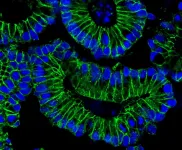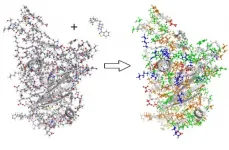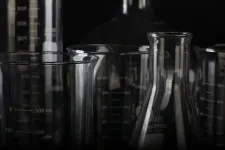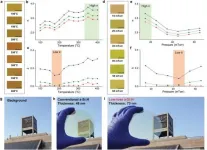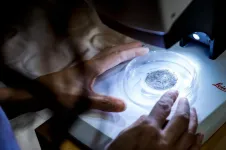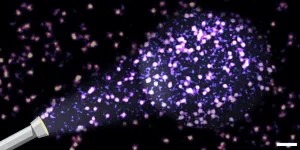(Press-News.org) Most people infected with SARS-CoV-2 are able to recover from the disease at home - even if they might experience very stressful disease progressions. Some have no symptoms at all. But about ten percent of those affected become so severely ill that they have to be treated in a hospital. The assumption that a weak immune system is behind a severe progression is short-sighted. Especially with critical progressions, the immune system works under intense pressure, but does not manage to control the virus.
A Berlin research group has now observed how SARS-CoV-2 uses an immune system defense mechanism to increasingly hijack the body's mucous membrane cells and multiply there. Their study has just appeared in the journal EMBO Molecular Medicine. "This may give us part of the explanation as to why the immune system has difficulty regulating or even defeating the infection in some people," says Dr. Julian Heuberger, scientist at the Division of Hepatology and Gastroenterology in Charité - Universitätsmedizin Berlin's Medical Department. He is the first author of the study and a member of an Emmy Noether Research Group led by PD Dr. Michael Sigal at Charité and the Berlin Institute for Medical Systems Biology (BIMSB), part of the Max Delbrück Center for Molecular Medicine in the Helmholtz Association (MDC). For the study, the research group cooperated with researchers from the Max Planck Institute for Infection Biology (MPIIB), Freie Universität Berlin and Hong Kong University.
SARS-CoV-2 uses defense mechanism as a port of entry
Actually, the human body has a very effective defense mechanism against invaders, based on the interaction of various immune cells. T cells play an important role in this: When they encounter viruses in the organism, they destroy the affected cells. They also secrete the signaling molecule interferon-gamma (IFN-γ). On the one hand, IFN-γ fights infectious agents. On the other hand, it calls other immune cells to the scene.
Heuberger and his colleagues have now shown how SARS-CoV-2 can turn this protective mechanism mediated by IFN-γ into its opposite. For in addition to immune cells, the body's mucous membrane cells also respond to IFN-γ by forming more ACE2 receptors. SARS-CoV-2 needs these ACE2 receptors as a port of entry into the cells. Infected cells, in turn, make more ACE2. In this way, both the IFN-γ response of epithelial cells and the virus itself intensify the SARS-CoV-2 infection.
Cell differentiation observed in colon organoids
Patients infected with SARS-CoV-2 sometimes show gastrointestinal symptoms. In order to observe the immune cascade in the intestinal cells, Heuberger cultivated organoids of the human colon. An organoid is a kind of mini-organ in a petri dish, barely the size of a pinhead. The colon organoids are based on cells that come from intestinal biopsies. They grow in three-dimensionally arranged units and replicate the physiology of mucous membrane cells in the human intestinal tract. "These colon organoids are a very helpful tool," Heuberger emphasizes. "We can use them to explore the complex interplay of different signaling pathways that control cell differentiation from stem cells to specialized epithelial cells."
The scientists first treated the cultured intestinal cells with IFN-γ to simulate the body's immune response. Then they infected the organoids with SARS-CoV-2. Using gene expression analysis and a laser scanning microscope - a special optical microscope that scans a sample point by point - they were able to measure increased ACE2 expression in the organoids. In addition, quantitative polymerase chain reaction (PCR) detected increased virus production.
In other words, more IFN-γ means more ACE2. More ACE2 means more viruses can enter the cells. The more viruses that enter the cells, the more viruses produced. Thus, the immune response and the surface cell response to infection pave the way for SARS-CoV-2.
Balancing an excessive IFN-γ response with medication
"We hypothesize that a strong immune response may increase the susceptibility of mucous membrane cells to SARS-CoV-2," says the head of the study, Dr. Michael Sigal. He directs the Gastrointestinal Barrier, Regeneration and Carcinogenesis Lab at Charité and the MDC and is a gastroenterologist at Charité. "If the IFN-γ concentration is higher from the outset or the infection triggers a very excessive production of IFN-y, the viruses probably have an easier time entering the cells." However, the conditions under which this actually happens must still be investigated in clinical trials.
The results of the study carry the idea of a treatment approach for severe COVID-19 courses, Heuberger feels: "One possible strategy could be to balance the IFN-γ response with drugs." However, this would first require a very detailed analysis of the mechanisms underlying the IFN-γ response.
INFORMATION:
Contact
Dr. Michael Sigal
Head of the Gastrointestinal Barrier, Regeneration and Carcinogenesis Lab
Max Delbrück Center for Molecular Medicine in the Helmholtz Association (MDC)
Charité - Universitätsmedizin Berlin
michael.sigal@mdc-berlin.de
The Max Delbrück Center for Molecular Medicine (MDC)
The Max Delbrück Center for Molecular Medicine in the Helmholtz Association (MDC) was founded in Berlin in 1992. It is named for the German-American physicist Max Delbrück, who was awarded the 1969 Nobel Prize in Physiology and Medicine. The MDC's mission is to study molecular mechanisms in order to understand the origins of disease and thus be able to diagnose, prevent, and fight it better and more effectively. In these efforts the MDC cooperates with Charité - Universitätsmedizin Berlin and the Berlin Institute of Health (BIH) as well as with national partners such as the German Center for Cardiovascular Research (DZHK) and numerous international research institutions. More than 1,600 staff and guests from nearly 60 countries work at the MDC, just under 1,300 of them in scientific research. The MDC is funded by the German Federal Ministry of Education and Research (90 percent) and the State of Berlin (10 percent), and is a member of the Helmholtz Association of German Research Centers. http://www.mdc-berlin.de
Computing - Modeling COVID dynamics
To better understand the spread of SARS-CoV-2, the virus that causes COVID-19, Oak Ridge National Laboratory researchers have harnessed the power of supercomputers to accurately model the spike protein that binds the novel coronavirus to a human cell receptor.
These simulations also shed light on the ligand molecules that can inhibit such binding, pointing the way to potential drug therapies.
An ultrafast quantum chemical modeling method provides information about the critical electronic interactions between protein and ligand chemicals, going beyond the classical interaction models that are normally employed in computational drug discovery.
The findings will enable accurate predictions of the performance of currently available inhibitors ...
The University of Kent has led a study highlighting the urgent need for the UK's Government and renewable energy industries to give vital attention to decommissioning offshore wind turbines approaching their end of live expectancy by 2025. The research reveals that the UK must decommission approximately 300 and 1600 early-model offshore wind turbines by 2025 and 2030, respectively.
Urgent focus is needed now to proactively use the remaining years until turbines installed in the 1990s and early 2000s are no longer safely functional in 2025, to prevent safety lapses, potentially huge costs and the irretrievable loss of the skillset required for safe decommission.
The research shows that these original turbines have an approximate lifetime of 20 to 25 years, but this expectation ...
Atropisomers are a class of stereoisomers (chemical compounds that differ in spatial arrangement of atoms) arising from restricted rotation around a single bond and have various applications in chemistry. To date, most research on atropisomers has focused on "biaryl atropisomers" (due to the rotational restriction around a carbon-carbon bond), but it is also possible for atropisomers to arise from rotational restrictions around a nitrogen-carbon (N-C) bond. These N-C axially chiral compounds are found in various natural products and bioactive compounds and thus have promising applications in medicine ...
A POSTECH research team has developed a transparent amorphous silicon that transmits visible light - which permits us to distinguish the colors of objects - enabling the development of paper-thin lenses usable in head-mounted displays (HMD) that show virtual and augmented reality images in real time.
A research team - led by Professor Junsuk Rho of POSTECH's mechanical engineering and chemical engineering departments, and Ph.D. candidate Younghwan Yang and Dr. Gwanho Yoon of the Department of Mechanical Engineering - has developed visibly transparent amorphous silicon by improving the plasma enhanced chemical vapor deposition (PECVD) method, a practice widely used by Korean display manufacturers. ...
Tsukuba, Japan - Sleep is very important for athletes, and sleep loss can affect physical performance and cognitive ability. But now, researchers from the University of Tsukuba have identified the prevalence of sleep disorders in visually impaired athletes, as well as specific risk factors associated with lower sleep quality.
In a study published last November in Sleep Medicine, researchers from the University of Tsukuba conducted a survey of 99 visually impaired athletes in Japan and analyzed data from 81 respondents. They found that approximately one-third of the respondents had sleep disorders. Further, higher levels of stress regarding interpersonal relationships ...
CORVALLIS, Ore. - Statistical modeling developed by Oregon State University researchers has confirmed that changes to melanoma patients' gut microbiome led them to respond to a type of treatment capable of providing long-term benefit.
Findings were published in Science.
The modeling technique invented by Andrey Morgun of the OSU College of Pharmacy and Natalia Shulzenko of Oregon State's Carlson College of Veterinary Medicine is known as transkingdom network analysis.
The human gut microbiome is a community of more than 10 trillion microbial cells from about 1,000 different bacterial species, and transkingdom network analysis integrates ...
Water is a necessity for all life but its availability can be limited. In geographical areas experiencing dry seasons, animals congregate near the few freshwater sources, often reaching large densities. At these sites many animals from different species come to the same spots to drink, potentially operating as key locations for pathogen transmission within and between species. An international team of scientists lead by the German Leibniz Institute for Zoo and Wildlife Research (Leibniz-IZW) suggests that viruses can use restricted freshwater sources as a vector to be spread among animals. The key prediction of this idea is that animal viruses remain stable and infectious in water. The team ...
The effects of microplastics on our health and the environment are being rigorously studied all across the world. Researchers are identifying microplastic sources and their potential routes to the environment by examining rainwater, wastewater, and soil.
Microplastics have been found in nearly all organisms and habitats everywhere in the world. However, factors contributing to the influx and accumulation of microplastics in water ecosystems aren't fully understood yet. The focus of microplastics research has, for a long time, been on the age of microplastics found in sediments, and on the ...
The researchers analysed cells, mouse models, and human patient samples using biochemical, mathematical, and biophysical methods. They identified a protein present in the mesh-like membrane structure (the basement membrane) associated with tumour and vessel softness, and good survival of cancer patients. The researchers tested if removing this protein from the basement membrane would enhance the spread of cancer, which it did, and if supply of this protein would reduce cancer spread, which it did. They proceeded to show that the levels of this protein (netrin-4) already present in basement membrane of organs may determine cancer spread even before cancer develops, ...
Cells of organisms are organized in subcellular compartments that consist of many individual molecules. How these single proteins are organized on the molecular level remains unclear, because suitable analytical methods are still missing. Researchers at the University of Münster together with colleagues from the Max Planck Institute of Biochemistry (Munich, Germany) have established a new technique that enables quantifying molecular densities and nanoscale organizations of individual proteins inside cells. The first application of this approach reveals a complex of three adhesion proteins that appears to be crucial for the ability of cells to adhere to the surrounding tissue. The research results have been published in the journal Nature ...
